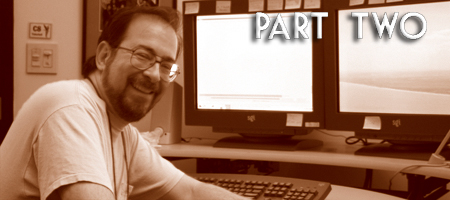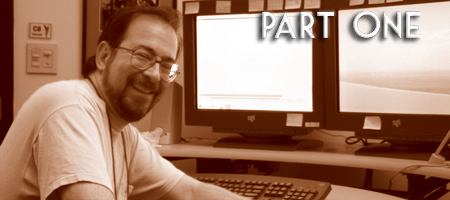Show 005 – Nik Ranieri, Part Two
In part two of the interview Nik Ranieri takes us through his early years in animation and some of the lessons learned before he got to Disney.
Get it here: Show 5: Nik Ranieri, Part Two

(13.1MB, 28:33 minutes)
Continue for Show Notes…
iTunes 4.9 supports podcasts
I was so excited this morning when I upgraded my iTunes software to see the new podcasting feature of the iTunes Music Store, and saw that The Animation Podcast is listed! Now there’s a place where all my shows are available in one easy list. I haven’t downloaded anything yet, but it looks super easy (hey, Apple made it). Now I’ve got to learn how to fill in a bit of information they don’t have from me, but thaz cool nazgul.
I’m not going to trash my iPodder and iPodderX just yet, but if this works the way it should, I don’t see much use for them anymore. This may be the simplest way to find and subscribe to many different podcasts so check it out and let me know what you think.
Here’s the link to The Animation Podcast at the iTunes Music Store. (The link only works on a computer that has iTunes installed.)
Show 004 – Nik Ranieri, Part One
The Animation Podcast returns with a Canadian invasion! Here’s part one (of many more) with Nik Ranieri. Nik tells us about going to Sheridan to learn animation and what good animation means to him.
Get it here: Show 4: Nik Ranieri, Part One

(11.1MB, 32:15 minutes)
Ones and Twos
I’ve already posted this in a comment and explained it in Show 3, but to keep things organized and findable, here’s where you can find my explanation of “What are ones and twos?”
ONES and TWOSHere’s my explanation of ‘ones and twos.’ I also talk about it at the end of Show 3. Film has 24 frames per second. Each frame has a different drawing, or image, and when they are viewed in succession through a projector, the images connect and create the illusion of motion thanks to what is called persistence of vision. That’s all simple enough. If each drawing is numbered according to which frame it falls on, it would look like this: 1 2 3 4 5 6 7 8 9 10 11 . . . In traditional (hand-drawn) animation, every frame can hold a different image but animators realized long ago that they could get by with only doing a drawing every other frame, saving extra work. The drawings would be “held” on two consecutive frames so that in one second, instead of doing 24 drawings (one every frame) they could do 12 drawings (one every other frame). The numbered drawings would look like this: 1 – 3 – 5 – 7 – 9 – 11 . . . and drawing 1 is repeated in frame 2, drawing 3 repeats in frame 4, etc. Persistence of vision comes into play again and the action still looks fluid. A drawing held for two frames is called “on twos.” Logically, when each consecutive frame has a new drawing, it is called “on ones.” It’s up to the animator to decide when to animate on ones and twos. Generally, the determining factor is how it will look in the end. If it is animated on twos (12 drawings per second) and there seem to be gaps in the action, the animator can go in and add new drawings to make it look more fluid. If this series of drawing doesn’t look smooth enough (between 3 and 7): 1 – 3 – 5 – 7 – 9 – 11 . . . we can add a drawing where it is needed like this: 1 – 3 4 5 6 7 – 9 – 11 . . . Something that didn’t make sense to me when I first heard it is that faster action should be animated on ones. I thought, “Well won’t more drawings slow it down?” Not really, since we’re not adding time. The frames stay the same, we’re just putting more images in to connect the action. You may think of it as a strobe light. If it flashes slowly (on twos) and you wave your arms around, it may be hard to follow the motion. If we speed up the flashing (on ones) the action connects visually because there are more images shown in the same amount of time. This is REALLY hard to get across in words alone, and I know I can tend to be verbose, but I hope this helps. If you pause traditional animation and advance frame by frame, you will be able to see which sections are on ones and which are on twos. Of course if you’re looking at some Saturday morning cartoons, they get away with animating on 12s, 24s, or worse. We commented about The Thief and the Cobbler in Show 2 because Richard Williams prefers to animate nearly everything on ones. CG is nearly always done on ones. In Fantasia 2000 some of the Tin Soldier sequence was animated on twos, but that is a rare instance. |
May was fun
Well, the month of May has come and gone with the launch of The Animation Podcast. I have to send out a BIG thank you to Andreas Deja for being my first guest. He was the perfect choice for many reasons, but I think most of all for his unabashed enthusiasm for animation. What a start!
I’m working on getting the shows going for June, so stay tooned.
I also MUST thank all of you who came and listened and especially those of you who took part by commenting, emailing, voice-messaging, and voting at Podcast Alley – we made it to number 14! That just blows my mind. Again – what a start! (Sidenote – Podcast Alley resets every month. I don’t expect you to vote since I don’t have a new show for June yet, but keep it in mind for later if you’d like to recommend the show.)
Anyhow, I appreciate the support. I’m going to try to keep making compelling shows for all of us to enjoy, hopefully for years to come!


Hi Clay, I just read on CartoonBrew that you're going to direct an angry birds feature. Great news, Congrats man!…